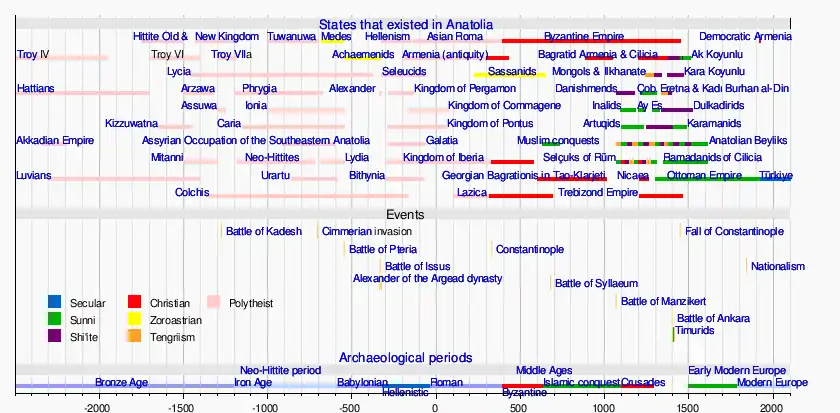Assuwa (Hittite: 𒀸𒋗𒉿, romanized: aš-šu-wa; Mycenaean Greek: 𐀀𐀯𐀹𐀊, romanized: a-si-wi-ja)[1][2] was a confederation of 22 states in western Anatolia around 1400 BC. The confederation formed to oppose the Hittite Empire, but was defeated under Tudhaliya I/II.[3][4][5] The name was recorded in various centres in Mycenaean Greece as Asiwia, which later acquired the form Asia.[2]
Name
Assuwa has been identified in Egyptian records as isy and a-si-ja and in the contemporary Greek Linear B script with the demonym a-si-ja.[6]
History
Assuwa appears in the historical record around 1400 BC. It is mentioned in six surviving Hittite documents including the Annals of Tudhaliya I/II, which gives a detailed account of the Assuwans' rebellion and its aftermath.[7][8][6]
But when I turned back to Hattusa, then against me these lands declared war: [—]lugga, Kispuwa, Unaliya, [-], Dura, Halluwa, Huwallusiya, Karakisa, Dunda, Adadura, Parista, [ ], [-]waa, Warsiya, Kuruppiya, [-]luissa, Alatra, Mount Pahurina, Pasuhalta, [-], Wilusiya, Taruisa. [These lands] with their warriors assembled themselves ......... and drew up their army opposite me.[9]
— Annals, obv.13'-21', adapted from trans. by Garstang and Gurney (1959: 121-2).
Circumstantial evidence raises the possibility that Ahhiyawans may have supported the rebellion. For instance, a Mycenaean-style sword found at Hattusa bears an inscription suggesting that it was taken from an Assuwan soldier and left as an offering to the Hittite storm god.[10][11][12][13][14] Some scholars have speculated that certain details in the Iliad could reflect a memory of this conflict, including the seemingly anachronistic character of Ajax as well as references to pre-Trojan War escapades of Bellerophon and Heracles in Anatolia.[7]
References
- ↑ Collins, Billie Jean; Bachvarova, Mary R.; Rutherford, Ian (28 March 2010). Anatolian Interfaces: Hittites, Greeks and their Neighbours. Oxbow Books. p. 120. ISBN 978-1-78297-475-8.
assuwa pylos "aswia" = Linear B A-si-wi-ja
- 1 2 Latacz, Joachim; Windle, Head of the School of Language Studies Kevin; Windle, Reader in the Department of Classical and Modern European Languages Kevin; Ireland, Visiting Fellow in the School of Language Studes Rosh (28 October 2004). Troy and Homer: Towards a Solution of an Old Mystery. OUP Oxford. p. 281. ISBN 978-0-19-926308-0.
Aswiai ; recorded several times at Knossos , Pylos , and Mycenae ; evidently refers to women from the region called Assuwa
- ↑ Beckman, Gary; Bryce, Trevor; Cline, Eric (2012). The Ahhiyawa Texts. Brill. p. 6. ISBN 978-1589832688.
- ↑ Bryce, Trevor (2011). "The Late Bronze Age in the West and the Aegean". In Steadman, Sharon; McMahon, Gregory (eds.). The Oxford Handbook of Ancient Anatolia. Oxford University Press. pp. 366–367. doi:10.1093/oxfordhb/9780195376142.013.0015.
- ↑ Bryce, Trevor (2005). The Trojans and their Neighbours. Taylor & Francis. pp. 107–108. ISBN 978-0-415-34959-8.
- 1 2 Cline, Eric H. “Achilles in Anatolia: Myth, History, and the Assuwa Rebellion,” in Crossing Boundaries and Linking Horizons: Studies in Honor of Michael Astour on His 80th Birthday, Gordon D. Young, Mark W. Chavalas, and Richard E. Averbeck, eds. (Bethesda, MD: CDL Press, 1997), pp. 189–210.
- 1 2 Cline, Eric H. 1177 B.C.: The Year Civilization Collapsed. pp. 35–36, 40–41.
- ↑ Rose, Charles Brian (2013). The Archaeology of Greek and Roman Troy. Cambridge University Press. pp. 108–109. ISBN 978-0-521-76207-6.
- ↑ Bryce, Trevor. The Kingdom of the Hittites. United Kingdom, Oxford University Press, 1999.
- ↑ Bryce, Trevor (2011). "The Late Bronze Age in the West and the Aegean". In Steadman, Sharon; McMahon, Gregory (eds.). The Oxford Handbook of Ancient Anatolia. Oxford University Press. doi:10.1093/oxfordhb/9780195376142.013.0015.
- ↑ Bryce, Trevor (2005). The Trojans and their Neighbours. Taylor & Francis. p. 59. ISBN 978-0-415-34959-8.
- ↑ Cline, Eric (2014). 1177 BC: The Year Civilization Collapsed. Princeton University Press. pp. 33–35. ISBN 978-0691168388.
- ↑ Beckman, Gary; Bryce, Trevor; Cline, Eric (2012). "Epilogue: Mycenaean-Hittite Interconnections in the Late Bronze Age Revisited". The Ahhiyawa Texts. Brill. ISBN 978-1589832688.
- ↑ Castleden, Rodney (2005). The Mycenaeans. Routledge. pp. 202–203. ISBN 9781134227822.
It was political instability of this kind, not just in Assuwa but all along the Aegean coast, that the Mycenaeans were able to exploit. One fragmentary letter mentions Assuwa and Ahhiyawa together, implying that the rebellion of Assuwa may have been supported by the Mycenaeans. Another (ambiguous) letter says 'the king of Ahhiyawa withdrew or retreated' or someone 'relied on the king of Ahhiyawa', so the Mycenaean king was either leading his army in Anatolia or supporting rebellion from afar.
